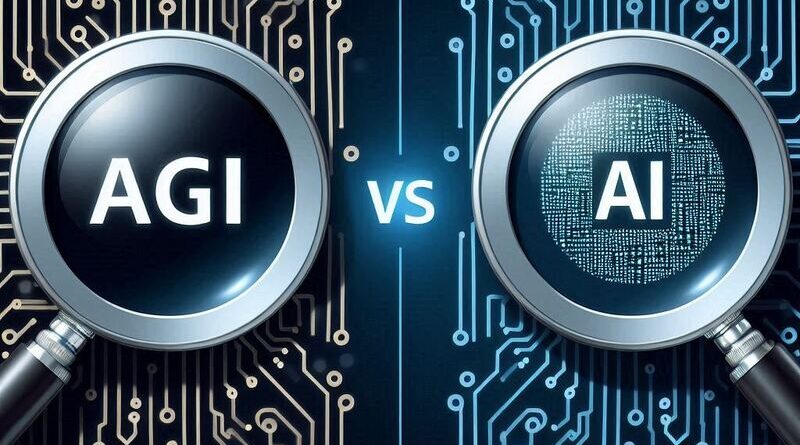Comparison between AGI (Artificial General Intelligence) and AI (Artificial Intelligence)
Introduction to Artificial Intelligence
- Definition of artificial intelligence (AI)
- Evolution and applications of AI in various domains
Understanding Artificial General Intelligence (AGI)
- Definition and concept of AGI
- Characteristics and capabilities of AGI systems
Types of AI
- Distinction between narrow AI, general AI, and superintelligent AI
- Overview of AI subfields such as machine learning, natural language processing, and computer vision
Scope and Potential of AGI
- Exploration of AGI’s potential to perform any intellectual task that a human can
- Implications for automation, creativity, and problem-solving
Current State of AI
- Overview of current AI technologies and applications
- Limitations and challenges in achieving AGI
AI vs. AGI: Key Differences
- Scope and versatility: How AI is task-specific while AGI aims for broad intelligence
- Adaptability and learning: AI systems are trained for specific tasks, while AGI learns and adapts across a range of tasks
- Cognitive abilities: AGI possesses human-like cognitive abilities, including reasoning, planning, and creativity
Applications of AI and AGI
- Examples of AI applications in industries such as healthcare, finance, and manufacturing
- Hypothetical scenarios of AGI applications and their potential impact on society
Ethical and Societal Implications
- Considerations regarding the ethical use of AI, including bias, privacy, and job displacement
- Speculation on the societal implications of AGI, including existential risks and opportunities for humanity
Development and Progress
- Current efforts and research initiatives in AGI development
- Challenges and milestones in the journey towards achieving AGI
Conclusion
- Recap of key differences between AI and AGI
- Reflection on the implications for society and the future of technology
AGI vs. AI: Understanding the Differences
In the ever-evolving landscape of artificial intelligence (AI), two terms often emerge in discussions: Artificial General Intelligence (AGI) and AI. While both are rooted in the concept of simulating human intelligence, they differ significantly in scope, capabilities, and implications. Let’s delve deeper into the distinctions between AGI and AI.
1. Introduction to Artificial Intelligence
Artificial intelligence, or AI, refers to the simulation of human intelligence processes by machines, typically computer systems. This encompasses a broad range of techniques and methodologies aimed at enabling machines to perform tasks that would typically require human intelligence, such as problem-solving, pattern recognition, and decision-making.
2. Understanding Artificial General Intelligence (AGI)
Artificial General Intelligence, or AGI, represents the hypothetical ability of an intelligent agent to understand and learn any intellectual task that a human being can. Unlike narrow AI, which is designed for specific tasks, AGI aims to replicate the broad cognitive abilities of the human mind across a variety of domains.
3. Types of AI
In the realm of AI, there exist various categories, ranging from narrow AI to superintelligent AI. Narrow AI, also known as weak AI, is designed for a specific task or set of tasks, such as speech recognition or image classification. General AI, on the other hand, possesses the ability to perform any intellectual task that a human can, while superintelligent AI surpasses human intelligence across all domains.
4. Scope and Potential of AGI
The scope and potential of AGI are vast and encompassing. Unlike narrow AI, which excels in specific domains, AGI holds the promise of versatility and adaptability across a wide range of tasks and contexts. AGI systems have the potential to revolutionize industries, automate complex tasks, and even exhibit creativity and problem-solving abilities akin to humans.
5. Current State of AI
As of now, the majority of AI systems deployed in real-world applications fall under the category of narrow AI. These systems excel in specific tasks such as natural language processing, image recognition, and predictive analytics. While narrow AI has achieved remarkable advancements in recent years, it falls short of the broad intelligence and adaptability exhibited by AGI.
6. AI vs. AGI: Key Differences
The primary differences between AI and AGI lie in their scope, adaptability, and cognitive abilities. AI is task-specific, trained for particular applications, and lacks the broad intelligence characteristic of AGI. While AI excels in specialized domains, AGI aims to replicate the full spectrum of human cognitive abilities, including reasoning, planning, and creativity.
7. Applications of AI and AGI
AI applications are ubiquitous in various industries, ranging from healthcare and finance to transportation and entertainment. These applications leverage AI technologies such as machine learning, natural language processing, and computer vision to automate processes, enhance decision-making, and improve user experiences. In contrast, AGI applications remain hypothetical, with speculative scenarios envisioning transformative impacts on society.
8. Ethical and Societal Implications
The ethical use of AI has emerged as a significant concern, with debates surrounding issues such as bias, privacy, and job displacement. As AI technologies continue to advance, it is essential to address these ethical considerations to ensure equitable and responsible deployment. The societal implications of AGI are even more profound, with discussions ranging from existential risks to the potential for unprecedented advancements in science, medicine, and governance.
9. Development and Progress
While significant progress has been made in the field of AI, achieving AGI remains a formidable challenge. Researchers and organizations worldwide are actively pursuing AGI development, but numerous obstacles must be overcome, including computational limitations, algorithmic complexity, and ethical considerations. Despite these challenges, ongoing research and innovation continue to push the boundaries of artificial intelligence.
10. Conclusion
In summary, while AI and AGI share the overarching goal of simulating human intelligence, they differ fundamentally in scope, capabilities, and implications. AI, represented primarily by narrow AI applications, excels in specific tasks but lacks the broad intelligence characteristic of AGI. As researchers and technologists strive to bridge the gap between AI and AGI, it is essential to navigate the ethical, societal, and technological challenges inherent in the pursuit of artificial intelligence.



